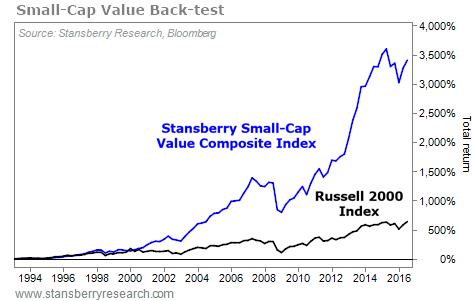Back in the fall, my team ran a screen for the best-performing stocks from 1996 to 2016.
Our goal was simple: Identify what factors can lead a stock to stupendous financial success, at a level that goes beyond virtually every other investment opportunity in the entire world.
[ad#Google Adsense 336×280-IA]These opportunities are every investor’s ultimate goal. But most people have no idea how they work… or that they can be predicted at all.
We now believe they can…
As I studied the 100 best-performing stocks of the last 20 years, I saw three common factors come up over and over again.
Not only that, but if you had invested in one of these stocks – assuming you reinvested your dividends – every single one delivered returns of at least 1,000% over that time frame.
Today, I’m going to tell you what these stocks had in common. And I’ll show you that these traits point to a group of stocks that can dramatically increase your returns… without increasing your level of risk.
Some of the companies on our list were in hyper-growth mode, while others were more established.
But despite covering a wide range of industries – including homebuilding, technology, retail, and even a railroad – these companies all had three things in common…
1. All of these companies had serious revenue growth in the years leading up to 1996.
On average, these companies increased their revenues by nearly 35% per year.
2. These companies all had strong operating margins.
The market’s best performers averaged margins of more than 37% from 1996 through 2016.
3. All of these companies were tiny.
It should come as no surprise that these companies were small-cap stocks in 1996, with an average market cap of less than $700 million… Once a company reaches a certain size, doubling its revenues and stock price every two or three years is no longer possible. Solid small companies are capable of scaling up revenues more quickly, and they tend to outperform over the long haul.
The point is, you don’t have to take a lot of risk to make a lot of money in small-cap stocks.
The famous Fama-French studies at the University of Chicago have thoroughly tracked how different segments of the stock market performed. They found that small-cap growth stocks are the best-performing investments you can make… and that investing in an index of these stocks would have brought in nearly 15% annualized total returns from 1927 to 2012.
In fact, just $1 invested in a “small-cap value” index back in 1927 would be worth around $140,000 today. (Meanwhile, $1 invested in the S&P 500 back in 1927 would be worth around $3,500 now.)
So… how do you find the best small caps?
My research team wanted an answer… so we built a hypothetical index. We wanted to see what would happen if you bought every small-cap stock trading at a reasonable valuation, with strong annual revenue growth and not too much debt.
In other words – we wanted to see if our three traits pointed to the best small-cap stocks.
What we found was that if you bought all of these stocks and rebalanced your portfolio every quarter, you would have returned around 3,400% over the last 25 years. As you can see in the following chart, the benchmark Russell 2000 small-cap index returned just 640% in the same time frame…

Of course, it’s not practical to buy every single small-cap stock and rebalance your whole portfolio every quarter. This is totally hypothetical.
The point is, if you’re looking to shoot fish in a barrel, you want to start in a barrel that’s chock-full of fish. That barrel is small-cap value stocks… And tracking them can be a fantastic way to generate huge returns.
There’s more to this system than I can cover here today. But it’s clear that focusing on small-cap value stocks can dramatically increase your returns… And you don’t have to take big risks to do it.
And if you invest in the right small caps, you might even end up with a 1,000%-plus winner…
Regards,
Porter Stansberry
[ad#stansberry-ps]
Source: Daily Wealth
